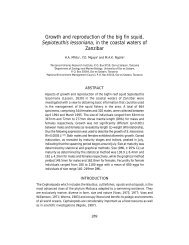gpa_east_africa_case.. - GRID Africa GeoPortal - UNEP
gpa_east_africa_case.. - GRID Africa GeoPortal - UNEP
gpa_east_africa_case.. - GRID Africa GeoPortal - UNEP
You also want an ePaper? Increase the reach of your titles
YUMPU automatically turns print PDFs into web optimized ePapers that Google loves.
elocation of the dumpsite at Kibarani to another area will release the site for recreation at thecost of $520,000 reflecting the minimum value attached to pollution-free recreation. Lack ofdata on the size of the population who will be using the area to derive a per capita value andapply it to the whole population, means that this category of benefits will be classified asqualitative.6. MangrovesMangroves are an example of an ecosystem generating both use benefits (poles, charcoal,fire wood, etc.) and non-use benefits (nursery grounds, coastal stabilisation, filtration, etc.).The distraction of mangroves is often caused by harvesting of wood for construction polesand firewood for the immediate needs of coastal communities. These community productshave a direct use value which should be compared to the indirect productivity of mangrovesfor fisheries in the adjoining areas. Data from Mozambique (Hatcher et. al. 1989) indicate thatthe mangrove yield is about 0.5 tons per ha, representing 40 kg per ha per year and a valueof $300 ha/year. The Kenyan coast has about 25,000 ha of mangroves giving an indirectvalue of $7.5 per year. There is no data on the area of mangroves lost in Mombasa, but usingdata form Mozambique for the period 1990-92 during which the average annual reduction ofmangrove areas was about 288 ha, or 2% per year, the indirect productivity cost may beestimated at $150,000 per year. The economic-environmental question is to compare thisindirect benefit loss with the value of poles and fire wood representing the direct use benefits.Without detailed reliable data to verify the net amount it is unwise to place a money value onthe loss of mangroves from an economic point of view. But certainly the cost of protection ofmangroves as an ecological system cannot be considered to generate no indirect value, forthe same reason that standing mangroves cannot be considered to have zero value.7. BiodiversityThe existence value of the environment is a very elusive parameter but one of potentially highvalue. It refers to the value that people themselves place on the preservation of theecosystem free of any use for productive activities. It is the social value of the ecosystem aspart of the natural heritage. The Kenyan coast is a rich ecosystem area characterised by coralreefs, diverse sea grasses and other marine life. Economic valuation is constrained by thedifficulty of establishing proxy values to make up for the lack of market prices and reveal thedemand for coastal and marine diversity. On the other hand, it is unwise to ignore biodiversityvalue and leave it outside the decision-making process. Estimates are typically based onContingent Valuation studies that attempt to utilise survey results which show the responsesof people to questions referring to their willingness to pay for conservation of coral reefs,excluding production and development considerations. There is no such information forKenya or any other part of the region. Such data are rare in any <strong>case</strong>. A recent review of theempirical biodiversity literature stresses the following:• Existence valuations are rare – only one study estimated the existence value of coral reefsites, that of the Great Barrier Reef;• Most valuation studies involve coral reefs are concerned with their recreational and touristuse value;• The most commonly valued harvested product of coral reefs is fisheries, but the naturalsystems underlying the harvest (e.g. reef-fish relationship) are simplified, if not ignored,and• Coastal protection afforded by the coral reef habitat is the only ecological function valued.Two known studies are often quotes. Hundloe 1987 estimated the existence value of coralreef habitat using a contingent valuation method for the value of coral reef sites within theGreat Barrier Reef in Australia calculated at A$45 million a year. For the Galapagos NationalPark, de Groot 1992 estimated the “inspirational” and “spiritual” value of reefs at $0.72 per ha.Cynthia Cartier and Jack Ruitenbeek, in Integrated Coastal Zone Management of Coral Reefsby Kent Gustavson (ed.), World Bank, 2000Final Draft Report – Cost Benefit Case StudiesGPA Strategic Action Plan on Sewage, October, 200025



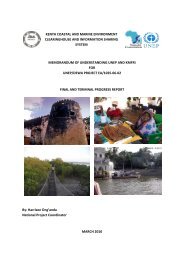
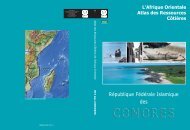
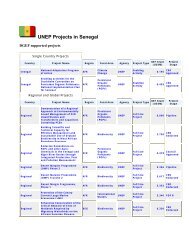

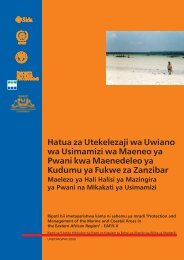
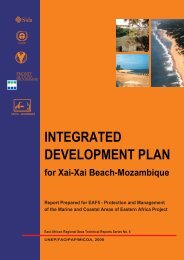
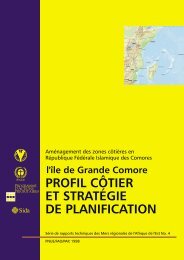
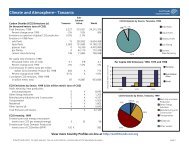

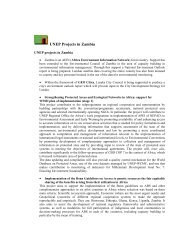
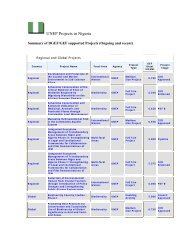
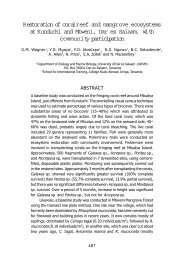
![Please Click to download [English] - GRID Africa GeoPortal - UNEP](https://img.yumpu.com/30633391/1/184x260/please-click-to-download-english-grid-africa-geoportal-unep.jpg?quality=85)
